|
Blue Pearl 3
|
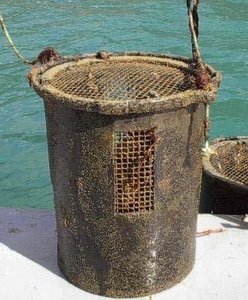 |
Fig. 8. A UV stabilized medium density polyurethane barrel, with water circulation vents, in which abalone are kept during pearl culture. Each barrel is specially conditioned, before paua are housed in them, by soaking the barrels in seawater for one month. This removes the plastic taste from the barrel, as abalone can not be housed successfully in new unconditioned barrels.
Blue Pearl 3
Good hygiene is very important if the abalone confined to these barrels are to maintain health and nacre secreting ability. Consequently, the abalone must be regularly removed from their barrels, their shells hand scrubbed to remove contaminants and parasites, and then checked for any infections--while the barrels are being cleaned by high pressure sea water to remove any debris, or adherent seaweed and other sea life.
While secured in these barrels, the implanted abalone will continue to spawn, with their fertilized larvae floating away to hopefully settle, grow naturally, and naturally Reseed the area in which the barrels are located. If this natural spawning tends to be irregular, then the farm often will introduce some peroxide into the water to stimulate the spawning of the abalone naturally.
The nucleation process
As some parts of this process are kept as closely guarded One month before the nucleation operation is due, ‘wild’ abalone of legal size are harvested by free divers. As the New Zealand Government has placed a quota system (bag limit) on the number of abalone that may be taken from the wild each year, each farm has to operate within the constraints imposed by this conservation-based system. This quota system prevents over fishing of the abalone. Abalone divers are specially trained so that they minimize injury to the abalone during capture and removal from their natural habitat. Following capture, the abalone are brought to the surface and placed in plastic barrels in a suitable holding area. The paua are nucleated on board a specially developed pearling vessel.
( You are on blue pearl 3 )
At the time of implant, the now-acclimatized abalone are removed from its holding barrels and a small hole or a series of small holes must be atraumatically drilled through the shell of each abalone to facilitate placement of a pegged implant under the mantle of the abalone. During this implant operation care must be exercised to ensure that the soft tissues of the abalone are not damaged in any way--for abalone are hemophiliacs and will bleed to death if cut.
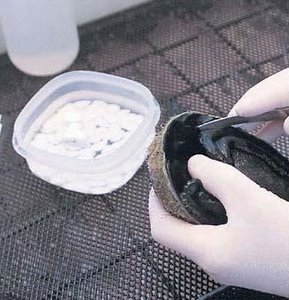 Fig. 9. Retraction of the body and mantle of the abalone to allow the pegged implant to be inserted in a hole drilled through the shell of the abalone. Blue Pearl 3 |
The implants, which are of proprietary design, are manufactured from moulded white plastic. They have a somewhat flattened hemispherical shape, diameters of from 8-14 mm, smooth outlines, a retaining peg projecting from the base of the implant, and they must have no projections or rough areas that can injure the mantle tissues of the abalone. No adhesive is used to maintain the implant in the shell.
Two implant locations seem to be used: one located around the periphery of the abalone’s shell and a second located deep within the shell near the shell’s internal whorl.
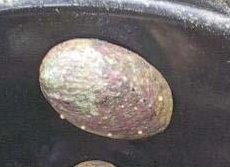 Fig. 10. Implanted abalone attached to the wall of a culture barrel for grow-out. Blue Pearl 3 |
Once the implant operation is completed, the ‘mother’ abalone are returned to their culture barrels (Fig. 10). Each barrel is given a number and a record is kept of the number of implanted abalone contained in each barrel.
Unlike pearl ‘oysters’, each abalone can only be nucleated once. One to five beads are nucleated in each abalone, depending on its size. Sizes of cultured half-pearls yielded after an appropriate grow-out period range from diameters of 6 –20 mm.
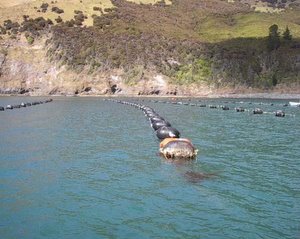 Fig. 11. On the pearl farm in Matt White Bay on the Banks Peninsula the culture barrels are suspended under water from ropes suspended from buoys in waters with good tidal flow. Blue Pearl 3 |
Eyris cultured half-pearls are farmed (grown out) for a minimum of two winters and two summers in black high density polythene barrels that are suspended from long-lines off shore (Fig. 11). During the time of grow-out the abalone must be regularly fed with a proprietary mix of freshly harvested seaweed. Its is a fact that the abalone are very fussy and are indeed gourmet eaters, for they like to eat seaweed that humans also find tasty and palatable.
( You are on blue pearl 3 )
Seaweed that produce the best display of colours in abalone nacre include an appropriate mix of:
• Macrocystis pyritera or giant kelp (Fig. 12A)--a large brown seaweed that has big leaves and a bulky, slightly coarse texture,
• Gracillaria (Fig. 12B), a fine filamentous red seaweed that has a fine texture, and
• Ulva, or green seaweed
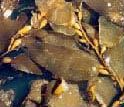 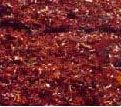 Fig. 12. Seaweed suitable for feeding implanted abalone. A – giant kelp, B – red seaweed Blue Pearl 3 |
The implanted abalone will consume up to 50 per cent of their body weight of seaweed each week, with their mix of food varying from week to week. Together with water temperature, pH and salinity of the seawater, it is the composition of mix of seaweed that is fed to the implanted abalone that determines the quality and iridescence of nacre secreted by the abalone.
To maintain a constant supply of the seaweed, this must be collected from the shorelines after a big storm, or deliberately harvested from kelp farms. Collecting shore-washed seaweed means that at that time ‘all hands must be on deck’ to collect seaweed, cut it into appropriate sizes, and then freeze or dry it for later use when no shore-washed seaweed is available for collection. Dried or frozen is simply rejuvenated by immersing it in fresh seawater. This rapidly brings back the shape and bulkiness of the kelp.
Some fine seaweed that grows on the culture barrels is also harvested and fed to the implanted abalone. With respect to abalone pearl culture it is important to remember that without reliable supply of quality seaweed, pearl farming would not be a viable operation.
End of blue pearl 3 ... go to next page.
Back to part 1
Part 2
Forward to Part 4
Part 5
Learn more about abalone pearls after blue pearl 3.
After reading blue pearl 3 maybe you'd like to share photos of natural abalone pearls you have found.
Have you found an abalone pearl? Add a page about it here. We'd love to hear about it and see a photo.
I hope you enjoyed blue pearl 3






